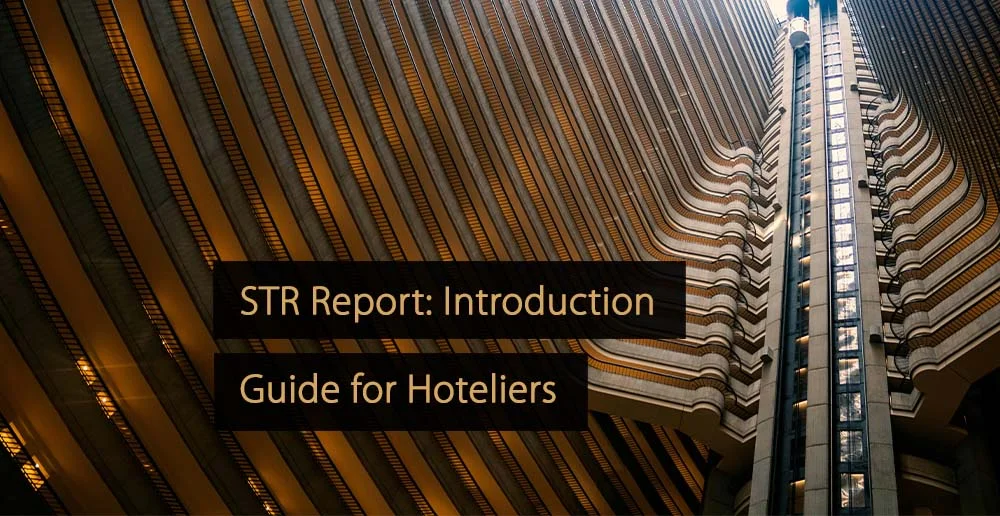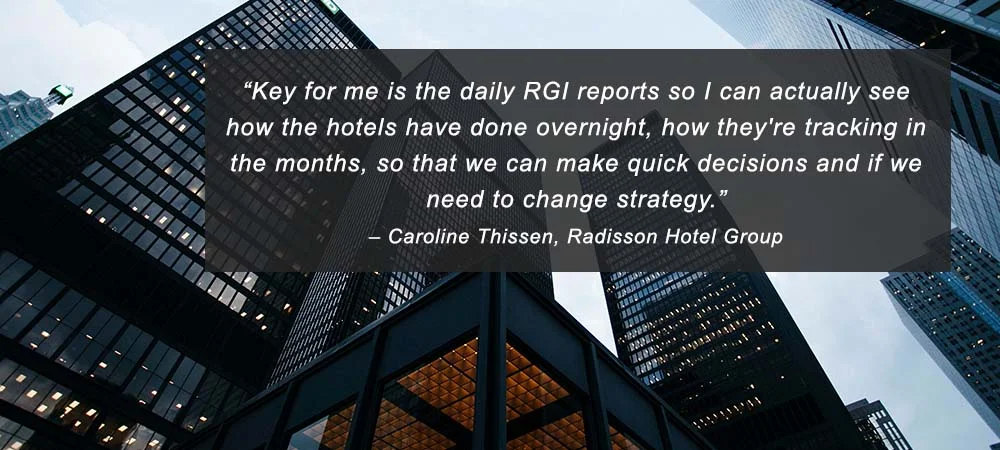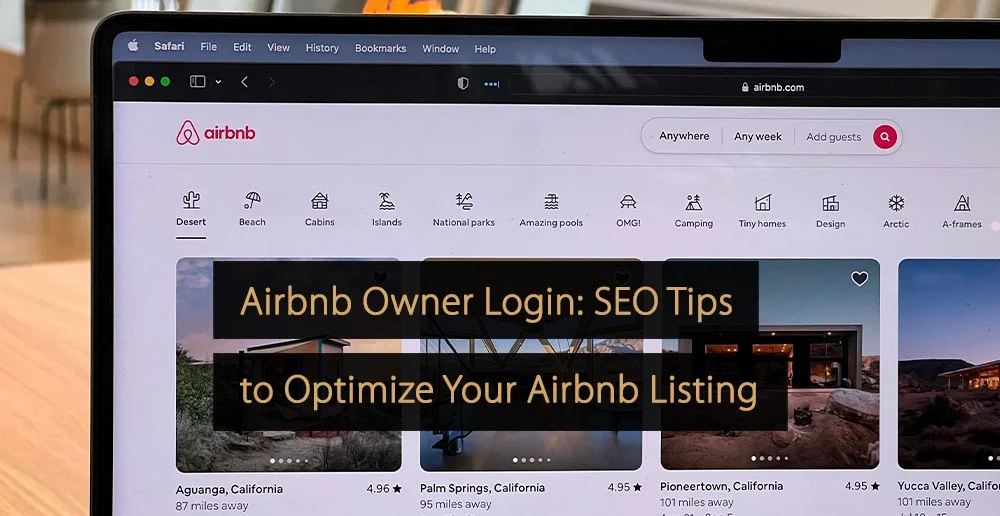An STR report, sometimes known as a STAR report, is a weekly, monthly, or annual report that serves as a benchmarking tool, helping you to understand your hotel’s performance within the context of rival hotels. In this guide, you can learn what an STR report is, how it works, what it can offer, and how to use it to your advantage.
Table of Contents:
- Overview of the Hotel Industry
- What is an STR Report?
- Why is an STR Report Important?
- Which Areas Does an STR Report Cover?
- How Much Does the STR Report Cost?
- How to Read Your STR Reports: 10 Crucial Steps
- Looking for Patterns and Trends in the Data
- Understanding Occupancy Rates
- Reading STR Report Index Numbers
- Analyzing Your Average Daily Rate
- Evaluating Revenue Per Available Room
- Exploring Market Segmentation
- Looking Closely at Supply and Demand
- Adopting Benchmarking for Comparisons
- Thinking About External Factors and Influences
- Using Your STR Reports Strategically
- How to Get an STR Report for Your Hotel
- Exploring the Basics of Hotel Management
- Keeping Up-to-Date With Hotel Technology
- The Most Significant Hotel Industry Trends
Overview of the Hotel Industry
An STR report is a benchmarking tool used by those in the hotel industry, but what is this industry, and how is it actually defined? Despite the name, the hotel industry actually encompasses all businesses that offer short-term, overnight guest accommodation to customers, including hotels, resorts, motels, inns, B&Bs, and hostels.
In the “Hotel Industry: Everything You Need to Know About Hotels!” guide, you will find a full hotel industry definition, along with a breakdown of the different business types within the industry. You will also be able to access additional resources covering hotel marketing strategies, hotel technology trends, and more.
What is an STR Report?
An STR report is a benchmarking report, produced by STR, Inc. The report provides data on your hotel’s performance and the performance of other hotels in your competitive set (compset). Your compset is a small group of rival hotels that compete for the same types of guests, making them your primary competition.
The STR report, also known as a STAR report, utilizes key performance indicators and can be used by a hotel owner to understand how their hotel performs compared to these key rivals. Over time, STR reports can help you to understand when your strategies are working, as well as when your hotel’s performance requires improvement.
Why is an STR Report Important?
While most hotels will already track performance metrics, the primary benefit of acquiring an STR report for your hotel is benchmarking. The report allows you to put your hotel’s performance into a wider context by comparing that performance to the performance of the other hotels in your compset.
This allows you to gain a deeper understanding of any changes in your performance and will tell you whether this impacts the wider market, or your hotel alone. By gaining access to performance data in your market, you can also optimize your hotel revenue management strategy, such as by adjusting your pricing or distribution.
Which Areas Does an STR Report Cover?
The STR report hotel owners and managers receive will cover a variety of key performance indicators for your hotel and your rivals. In the sections below, you can briefly learn what the main KPIs are:
- What is ADR? ADR stands for average daily rate and measures the average daily revenue generated for a paid, occupied room. It is calculated by dividing total room revenue by the number of rooms sold.
- What is RevPAR? RevPAR stands for revenue per available room. It is a performance metric that can be calculated either by dividing total room revenue by the number of rooms available, or by multiplying ADR by the occupancy rate.
- Occupancy rate is a metric that reveals valuable information about room utilization and demand levels. It is calculated by dividing the number of rooms sold by the number of rooms in the property.
- Market segmentation breaks down important performance data into different customer types, such as transient guests or groups. This helps hotels to tailor their marketing strategies more effectively.
- Supply and demand trends help hotel leaders to understand levels of demand and wider market conditions, so that strategic pricing and other revenue management strategies can be much more evidence-driven.
How Much Does the STR Report Cost?
STR, Inc. offers three different report types, the most basic being free in exchange for your hotel agreeing to submit its data. However, this only offers a limited amount of data in return.
A second option, known as a trend analysis report, is available for hotels that pay a one-time fee of around $600. This report provides valuable information about the hotel industry as a whole, but does not provide the level of individual performance benchmarking that the main STR report offers.
In most cases, the STR report hotel figures are most interested in is the in-depth benchmarking report, where you access data about your hotel’s performance compared to your compset. These reports are typically accessed every week, although other models are available. Pricing is not made public, and hotels must contact STR, Inc. to find out what they will need to pay and what the different subscription, payment, and distribution options are.
How to Read Your STR Reports: 10 Crucial Steps
The sections that follow will provide you with some useful advice on how to read your STR report each week.
Video: Hotel Revenue Management – Reading a STR Report [Beginner]
1. Looking for Patterns and Trends in the Data
In general, the best way to read your STR report is to look at the abundance of data provided and look for patterns and trends. Some of these trends and patterns could be short-term, such as patterns that are apparent from one week to the next, while others could only become apparent with a longer-term view.
The “glance” section of your report can be especially useful for this purpose, as it provides snapshot information about your hotel’s performance and the performance of your compset, for quick comparisons.
2. Understanding Occupancy Rates
Occupancy rates for your hotel and your compset will be shown on the report, but it is important to understand what this information is actually telling you. Occupancy rate is a KPI, shown on your STR report as a percentage, which explains how much of a hotel’s available rooms are actually being used during a specified period of time.
A high occupancy rate is usually considered a sign of good performance, as it suggests that room demand is high and the hotel is using available space effectively. Over time, it should be possible to see patterns with demand. However, it does not always correlate with optimized revenue, as high occupancy could result from low room rates.
3. Reading STR Report Index Numbers
One of the most valuable aspects of the STR report is the index numbers, which cover the areas of occupancy, ADR, and RevPAR. However, your results and the results of your competitive set are all factored into the values given.
The way STR report indexes work is by dividing hotel performance by overall compset performance, then multiplying it by 100. An index score of 100 means your hotel captures a fair share compared to your compset. Anything below 100 indicates underperformance, while anything above 100 suggests overperformance compared to these rivals.
4. Analyzing Your Average Daily Rate
Your STR report will show a percentage figure representing your average daily rate (ADR). This figure tells you the average amount your guests are paying to stay in your hotel. When you look at this figure holistically, considering other metrics like your occupancy rate, it can help to provide you with revenue management tips or hints.
In particular, monitoring your ADR and comparing the figure to your main rivals can help you implement the right pricing strategy at the right time. In general, you want to maximize ADR, without negatively impacting occupancy.
5. Evaluating Revenue Per Available Room
Revenue per available room, or RevPAR, is a great metric for measuring your revenue management trends, because it provides information about your revenue and your occupancy simultaneously.
The RevPAR KPI is best used to make comparisons with rivals, or to compare similar time periods. For instance, you might compare your hotel’s RevPAR from one weekend to the next weekend. If the RevPAR figure on your STR report increases, it indicates that your occupancy rate has increased, your room revenue has increased, or both.
6. Exploring Market Segmentation
The market segmentation element of your STR report breaks down your performance metrics, like ADR and RevPAR, but does so based on types of customers, such as groups, transient guests, and contract agreements.
Using this information, you can then dive deeper into your performance statistics and look for trends among each of the market segments. This allows you to make strategic choices, like targeting a specific segment more.
7. Looking Closely at Supply and Demand
Your hotel decision-makers need to understand the relationship between supply and demand within the hotel industry. Essentially, demand refers to the number of hotel guests who are willing to pay to stay on your property, while supply refers to the number of hotel rooms that you have available on your property.
Both of these numbers need to be continually monitored, as they can inform business strategy. For instance, if your hotel is constantly experiencing high demand, even with prices being raised to maximize revenue, hotel expansion could be beneficial. If demand is low, it could be beneficial to lower room rates to try to attract customers.
8. Adopting Benchmarking for Comparisons
An STR report for hotel revenue management is primarily a benchmarking tool, and hotels must use the reports in this way. Keep an eye on your own performance metrics and those of your competitors.
It is only when you use the performance metrics provided in the STR report for benchmarking that you will truly understand your hotel’s performance in context. If your metrics are ahead of your competitors, this could be a good sign even if they are down from previous weeks, because you have to consider the wider realities.
Video: Benchmarking with the STAR Report
9. Thinking About External Factors and Influences
When you are interpreting the information in your STR report, you need to remember that the performance metrics alone can only tell you so much. While a drop in ADR or RevPAR may indicate room for improvement in your revenue management strategy, it could also be a sign that there are external influences and factors at play.
You need always to consider factors that may be outside of your control. Improvements to your metrics could be the result of your own actions, but they may also be related to local events or holidays. In situations where natural disasters occur, or major global events like the COVID pandemic occur, you may not be able to take data at face value.
10. Using Your STR Reports Strategically
Ultimately, your STR reports will only provide you with information on your current performance and the performance of the hotels in your compset. It is up to you to make sure the information is put to good use.
By continually tracking your KPIs and taking the time to understand wider market conditions, you can gain the necessary insight and context to truly understand whether your hotel is performing well. The information can then be used to implement new pricing strategies, distribution strategies, and marketing strategies.
How to Get an STR Report for Your Hotel
There are various ways to acquire the full benchmarking STR report hotel leaders and revenue managers seek. The easiest way is to approach STR, Inc. directly. This can be done by visiting the company website and contacting the customer service team or filling out the ‘request a demo’ form on the site.
An ongoing subscription will likely be required, and this will most commonly involve receiving the reports weekly and paying a weekly subscription fee. Communicating directly with STR, Inc. is the recommended pathway for most hotels. However, some hotels can access their STR report through other means.
For instance, if you are working within a large hotel chain, you may find that access to STR reports is already available. Similarly, if you have affiliations with certain industry organizations or associations, including management organizations, it is possible that they can offer access to regular STR reports as a benefit.
If you work with research organizations, they may be able to provide access to STR reports, or similar data. It is also worth speaking to revenue management experts and others with relevant expertise and experience, as they may have connections with STR, Inc., and it may be possible to acquire reports at a lower price.
Finally, if you or your employees attend industry events and conferences, it is worth looking out for the presence of STR, Inc. If you communicate with the organization on a personal level, you may be able to reach a deal that would not be available through conventional channels, or you may be able to access sample reports or case studies so you can get a clearer sense of what the STR report will offer and whether it is right for your hotel.
Exploring the Basics of Hotel Management
An STR report is a valuable hotel management tool, but analyzing this data is only one part of a much larger job. Management positions require balancing numerous responsibilities, including marketing, revenue management, keeping up with emerging trends, managing staff, and recruiting new employees.
In the “Hotel Management: Everything You Need to Know About Managing a Hotel” guide, you can find useful information about hotel management, its history, the job requirements, and the core duties.
Keeping Up-to-Date With Hotel Technology
Away from revenue management and your STR report, you also need to keep your finger on the pulse when it comes to new technology. For instance, hotels are now increasingly reliant on ChatGPT and similar AI technology, guests increasingly expect smart hotels with smart devices, and it is crucial to keep up with cyber security standards.
In the “Hotel Technology Trends: 20 Upcoming Innovations of 2024 You Must Know” guide, you can learn about these tech trends and many others, so you can live up to customer expectations in the months and years ahead.
The Most Significant Hotel Industry Trends
Making effective use of your STR report involves identifying and analyzing data trends. Yet, on top of this, hotel leaders also need to be aware of wider hotel industry trends, with some current examples including increased interest in sustainable travel, a heightened focus on wellness, and the rise of ‘bleisure’ travel.
In the “Hotel Trends: Discover The Latest Hotel Industry Trends for 2024!” guide, you can learn about some of the most important and significant trends that are impacting hotels at the current time.
An STR report, or STAR report, is a useful benchmarking tool, allowing you to compare the performance of your hotel with the performance of other hotels in your competitive set. This helps to give further context to your key performance indicators and allows you to implement evidence-based revenue management techniques.
More Tips to Grow Your Business
Revfine.com is the leading knowledge platform for the hospitality and travel industry. Professionals use our insights, strategies, and actionable tips to get inspired, optimize revenue, innovate processes, and improve customer experience.Explore expert advice on management, marketing, revenue management, operations, software, and technology in our dedicated Hotel, Hospitality, and Travel & Tourism categories.








This guide is helpful! I appreciate how you’ve broken down the STR report and its importance for hoteliers. The tips you’ve shared on analyzing the data effectively will make a difference in our decision-making process.